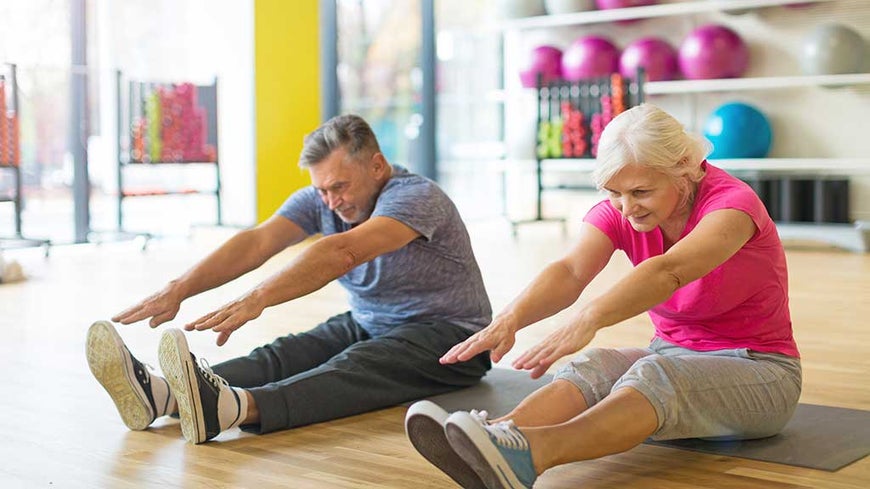Strengthening exercises for bones and health for seniors

Physical activity is vital for both the body and mind; helping build muscle, maintain weight, and manage blood pressure, cholesterol, and diabetes. Exercise is also associated with lowered risk of heart disease, stroke, some cancers, falls and injuries, and osteoporosis.2 So, it’s clear exercise is great for seniors, but what type of exercise should you be doing, and how?
Why strengthening exercises are good for you
As we age, our bones start losing density. When this becomes severe, it’s known as osteoporosis and the risk of bone breaks become higher. Around 10 million Australians have osteoporosis2, with half of all women over 60 and one-third of men over 60 suffering from it.3 Symptoms include back pain, reduction of height and bone breaks. Sufferers may be unaware they have it until something serious like a fracture happens.
Along with getting sufficient calcium and vitamin D, you should do regular exercise to reduce the risk of osteoporosis. Even if you already have it, exercise could be beneficial for helping fight bone loss.3
This is because exercise can build bone (osteogenic capacity), reduce bone loss, and help you conserve remaining bone tissue. It also indirectly enhances your general health by improving your fitness, posture, muscle strength, reaction time, mobility, balance, and coordination. Studies have also found exercise can reduce the risk of bone fractures by up to 95 per cent.4
Studies have also found that exercise can reduce the risk of bone fractures by up to 95%.4
Types of strengthening exercises to try
Progressive resistance training, mixed with a range of moderate-impact, weight-bearing exercises is best for boosting bone density and preventing bone loss. Exercises focused on balance, posture, and mobility might not directly affect bone density, but they can support bone health by reducing the risk of falls and resulting fractures or breakage.5
Weight-bearing exercises
Weight-bearing exercises, where you are bearing your own weight, could be positive for bone health and general well-being.6 Brisk walking, jogging, skipping, basketball, netball, tennis, impact aerobics, stair walking, and jumping are examples of weight-bearing exercises.
Resistance training
Another type of exercise that could help improve bone health is resistance training.3 This involves specific types of movements using free weights such as dumbbells and barbells, elastic band resistance, body-weight resistance, or weight-training machines. You can hold weights in your hand or strap them to your body as you do the movements, or even use your own body weight as the load.7
Note, you don't need expensive equipment to do resistance exercises. Movements like calf raises, knee flexions, hip extensions, and leg raises can be done at home - and all you need is a chair.
Doing resistance exercises three times a week could help you maintain healthy bones. For the best results, try a progressive program where it becomes more challenging over time.7
Balance and posture
Exercises like tai chi can be used to enhance posture, balance, and strength. Other balance exercises include standing on one leg, sitting on an exercise ball, and balancing with a pillow or rocker board under your feet.3
Non-osteogenic exercises
Non-osteogenic exercises, which are exercises not as effective at building bone, include swimming and cycling. While they can get you moving and help you keep active, they don't necessarily strengthen your bones.6
What to avoid doing
Avoid high-impact exercises and anything involving loaded rotation, or flexion and twisting of the spine. Focus on weight-bearing, muscle-strengthening, and balance-training activities. Begin with a gentle program and gradually increase the level of weight and resistance.4
If you have weak joints or a weak pelvic floor, you might want to avoid high-impact activities and do more balance-focused exercises like tai chi.1
Exercise safely
Remember, exercise has to be regular and ongoing to have an impact, so do it at least three times a week and ensure weight, difficulty, or challenge levels increase over time. Regular short and intensive sessions are also better than one long, slow session. But always get your doctor's advice when starting a new exercise program. You might want to consult a physiologist, physiotherapist, or exercise expert for help on designing a safe and effective exercise program.5
Australian Seniors is a leading insurance provider for the over-50s.To find out more about our range of insurance policies, contact our friendly team now for more information.
8 Oct 2018